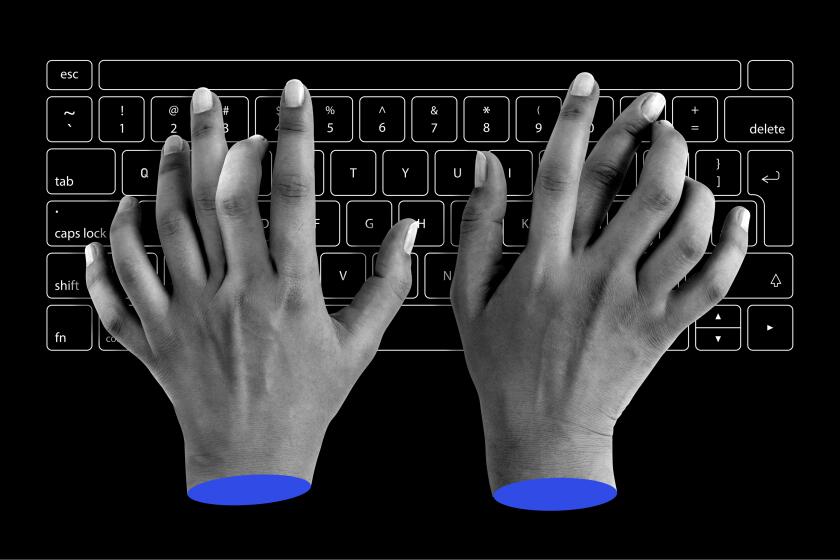Western Digital Renegotiating Long-Term Debt : Computers: The Irvine maker of disk drives reported a $98.5-million second-quarter loss and is seeking refinancing of the $160 million it owes.
Western Digital Corp. said Friday that it has entered into negotiations with lenders to refinance $160 million in debt and reported a $98.5-million second-quarter loss largely due to a onetime charge from an ongoing restructuring.
The company, a maker of computer disk drives, semiconductors and other components, has asked banks to roll over current loans as they come due and suspended loan payments until renegotiation of its long-term debt is completed.
The company, the largest high-technology company based in Orange County, missed a payment on a $10-million loan, but on Friday afternoon the lender agreed to renew the company’s credit on a day-to-day basis. Another $40 million in short-term loans come due in the next 30 days.
Roger W. Johnson, chairman and chief executive of Western Digital, said the temporary waiver will allow the company to renegotiate its debt over the coming months. However, additional defaults could accelerate payment of $235 million in borrowings, the company said.
That prompted Standard & Poor’s, a debt-rating service, to place $59 million of convertible subordinated debentures on its credit watch list for possible downgrade.
“The company’s $98.5-million second-quarter loss, which included a $66-million business restructuring charge, reflects severe price competition and a shift in the product mix toward growing but lower margin products,” S&P; said in a statement.
The second-quarter loss on revenue of $230 million for the period ended Dec. 31 compares to net earnings of $8.6 million on revenue of $265.6 million for the same three months a year ago. The company lost $96.8 million on sales of $485.8 million for the first six months of the fiscal year, compared to net earnings of $5.9 million on revenue of $490.9 million a year ago.
Johnson said he expects the company will lose money in the third quarter and, barring a “deepening recession” that impacts the personal computer industry, return to profitability by the fourth quarter.
Several Wall Street analysts said the second-quarter loss was expected, but the depth of the company’s problems took some by surprise. The company’s stock fell $1.875 to $4.50 in trading Friday on the New York Stock Exchange. With 3.13 million shares traded, it was the third most active stock on the NYSE.
“It looks terrible,” said Steve DeLuca, an analyst for Cruttenden & Co. investment banking in Newport Beach. “We knew there would be losses, but everybody was expecting some decent news.
“Still, in the long term, I’m positive about their strategy.”
Johnson insisted that the company was not desperate for cash--it had $39 million in cash at the end of the second quarter--and was preserving it for strategic reasons. “This isn’t a strategic retreat, it’s a strategic refocus,” he said.
Analysts agreed that the company is facing just a short-term credit crunch. Most were optimistic that it can survive the tough times by introducing a promising line of new high-volume products for the notebook computer market in the coming months.
In the corporate restructuring that began in December, Johnson said Western Digital is making a fundamental shift in the way it sells its computer products, moving away from low-margin sales of add-on computer boards to storefront resellers and switching instead to higher-margin sales of chips and disk drives to computer makers.
In the second quarter, the company turned down $33 million in reseller orders and received $17 million in returned inventory from the resellers as a result of an acceleration in the schedule for the restructuring, Johnson said.
In line with its shifted marketing plan, the company closed a board-making plant in Puerto Rico and cut about 600 jobs or 7% of its worldwide staff to reduce its overhead. Johnson said the company is considering closing one or possibly two of its four remaining board-manufacturing plants in Irvine, South Korea, Ireland and Singapore.
“If we close another plant, there will be more layoffs,” Johnson said. “We have not made any decision yet. There will also be a reduction in force as we continue to improve productivity so I wouldn’t rule out additional reductions.”
The company has also reorganized its five business units into a single corporate entity reporting to Kathryn A. Braun, executive vice president. Rather than being categorized by type of product, the business units are divided into engineering, marketing and manufacturing.
Western Digital’s eight-year strategy was to acquire businesses in each of the vital components of personal computer technology to become a one-stop supermarket for computer manufacturers. More recently, it is focusing on “interarchitecture,” or its ability to design closely related parts concurrently to improve overall performance of the computer system.
But beginning in the fall, after the invasion of Kuwait in August tipped the economy into a recession, Western Digital got caught in an ill-timed transition between technologies. Before it could bring production of new disk drives on line, demand for the company’s older board products fell off a cliff.
“They were probably a little too ambitious in building up to be all things to all computer manufacturers,” said Richard Whittington, analyst for Kidder, Peabody & Co. in New York. “They are recognizing that today.”
But Whittington said one “wild card” that could affect the company’s outlook is its long-rumored deal to manufacture a range of components for International Business Machines Corp.’s planned notebook-sized computer.
Johnson confirmed Western Digital designed and manufactured the motherboard, or main computing unit, in the test notebook computers which IBM shipped to students at Harvard University in January. He declined further comment on a deal with IBM.
Whittington said the benefits for Western Digital depend on whether IBM sticks to its revised schedule for a March introduction of the notebook computers and the market demand for the product.
“I haven’t written them off, but I am not recommending the stock until I get a better definition of the bank negotiations,” Whittington said. “I think they can renegotiate successfully because it’s easier now that the (Federal Reserve Board) is easing on interest rates, but the next 60 to 90 days will tell.”
Johnson also confirmed previous reports that the company is discussing the sale of its networking products division because it doesn’t fit with the company’s redefined strategic focus on producing closely related computer components whose functions can be integrated.
Whittington said the sale of the profitable networking business could raise about $25 million to $40 million.
But some analysts said such a move would mean the company would abandon some of its broader aims, making it more dependent on its intelligent disk-drive business. The company has a number of disk drives coming into high-volume production, but that industry is becoming more price-competitive, which is pushing profits down.



